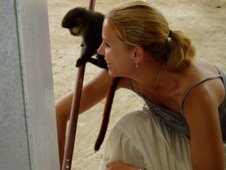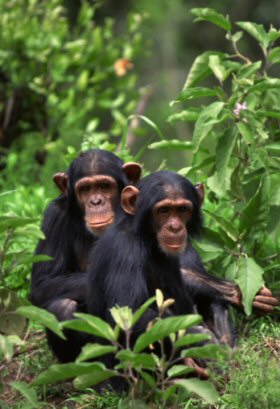Today’s post is a lot more somber compared to last weeks, however the topic I am about to discuss is one that has been weighing on my mind a lot over the past week. I feel this is an important issue to discuss. Hopefully this post will give you all an idea of the situation the chimps and many other wildlife here are facing.
The chimps that live in the forest around our site are living in a forest that has been heavily logged, and until just the past week I had no idea how heavily logged their territory really was. For the past week, Alex, Kennedy and I have not been able to find the chimps. While we have been hearing many vocalizations from them, and often very close by, we have been unsuccessful at actually seeing them. Sometimes their calls sound like they are directly beside us, unfortunately, since they are not fully habituated, as we move closer they also move, but farther away from us, making it impossible to actually capture a glimpse of them. This situation has been somewhat discouraging, but so goes field work…you have good days and bad days and some weeks are harder than others. I’m just thankful that I get to spend every day in the forest!
Anyway, back to our issue at hand, logging. Alex, Kennedy and I have been walking through the forest a lot more over the past week in our search for the chimps, therefore becoming more familiar with the terrain and territory of our group. I have come to realize that their entire forest is actually many small patches of forest connected by grasslands and logged areas. Yesterday we came across 13 different logged sites, and 5 of these were all within several hundred meters of each other. If logging continues at the rate it has been, the forest will soon become smaller and smaller patches and the grasslands in between will widen, making it not only difficult, but also dangerous for the chimps to move among the forest patches. Let me explain the difference between the grasslands and the logged sites. The grasslands are large open areas in the middle of the forest that are now completely covered by grasses. The logged sites, on the other hand, are areas still within the forest patches; however there is a large open space in the canopy where you can see the sky clear as day. There is still undergrowth on the forest floor in the logged areas though. These logged areas are usually approximately 20 to 50 meters in diameter, whereas the grasslands can be as wide as 500 meters or so.
Not only does/is the logging affecting the chimps in terms of destroying their area to live and move in, loggers are also heavily targeting fruiting trees, and many of these trees are ones the chimps feed on. As the chimps lose their feeding trees, their territories actually have to expand in order for them to encompass enough fruiting trees to feed the group. This loss of trees, also leads many of the chimps to crop raid in an effort to supplement their diet with enough food for survival. Naturally, the local farmers are less than please with the crop raiding, and often they are driven to secretly killing the chimps in an effort to temporarily deal with the crop raiding problem without a large expense.
As the chimps lose their feeding trees this also makes our job, as researchers, more difficult because it means the group often divides into many smaller groups in order to feed in different areas, ensuring enough food for the group. This often means the chimps do not stay in one area very long, and therefore, it becomes a huge guessing game for us as to where to look for the chimps each day when they aren’t consistently coming to a feeding tree everday. How do you guess where the chimps might be when they aren’t calling in the morning and their home range spans 7 kilometers or more? This is the question I’ve been trying to solve everyday for the past week. Sometimes we get lucky and guess right, and other days, like today, we fail.
The issue of logging has been fascinating me for the past week; therefore I have been discussing this issue a lot with our field assistant, Kennedy. I’m trying to learn all I can because the measures that are currently in place to try and prevent/stop the logging do not appear to be working very well. Yesterday, Alex, Kennedy and I chased after 3 different groups of loggers in the forest. This was one of the most exhilarating and yet terrifying moments of my life. In general, the loggers are more afraid of us than we should be of them, as they don’t know who we’re working for and automatically assume we must be with the National Forest Authority (NFA) here in Uganda, therefore they run as soon as they see or hear other people. The forest we work in is a protected reserve, and therefore all logging is illegal…however this gets a bit more complicated which I will explain in a moment. Of course, Alex, Kennedy and I are not with the NFA, but apparently they also fear muzungus (white people) and especially researchers. I kept thinking to myself though, as we were running through the forest, darting trees trying to chase these groups of men…what would they think/do if they saw that we were actually only 2 small white females and an even smaller Ugandan man?…would they be so afraid or would they just take a ponga to us to prevent us from reporting them. Kennedy says the loggers are nothing we should fear, and that they would never harm us. They know they’re in the wrong and they apparently are afraid of the tracking gear the muzungus come with (our GPS), so I was holding this high as we ran, just so they would know we can track them and the exact site they were at. Thankfully, the loggers just ran and hide yesterday, and we reported the sites we found to the NFA. Hopefully they were able to come and take the wood, and destroy the cutting tables before the loggers were able to transport the wood out of the forest and sell it themselves.
Now here’s where the story becomes murky. First off, when the NFA patrols the forest, and they come across a logging site, they take the wood and then sell it themselves. Now I suppose, what do you do with a tree that has already been cut down, right? You can’t stand it upright again and call it a day, acting like nothing happened and hoping it grows back again, so the NFA takes it, sells it, and then supposedly puts the money from the sale back into the NFA (salaries for rangers, up keep of buildings and such). Somehow though, this just leaves me with a bad taste in my mouth. Here’s the best part of the NFA’s rules though. While the Budongo Forest, where we work, is a protected reserve, the only tree that is 100% illegal to cut down is the Mahogany tree. All other trees in the forest can be cut down if one has a permit for this act. And the permits are very easy to obtain!! All one has to do is walk into an NFA office and request one, no questions asked. Unfortunately there is quite a lot of logging occurring that is done without permits, but the permits do help increase the amount of logging that occurs.
The story doesn’t end here though. The majority of the logging is conducted at night. Eight, ten, twelve men will come in at night with hand saws and axes and take down enormous trees. Then a few nights later they’ll transport the cut wood to the forest edge where it will be loaded onto a lorry and carried away by the truck loads to Kampala in the middle of the night when the NFA isn’t watching. The NFA never has rangers patrol at night! They know this is when the majority of the logging is occurring, but they don’t deploy their rangers at this time. It is beyond me why they wouldn’t find it important to invest money in night rangers. In addition, the loggers out smart the NFA in a sense. They will watch the movements of the NFA rangers, and if they watch a ranger go through the site on Wednesday, they know he will not be there again the next day, so then they come on Thursday and cut all the trees down. How can the NFA, not be on to these scams? They should sit and wait, hiding, at these sites, when they come across them, waiting for the loggers to return…they always do. Even yesterday, only 40 minutes after we chased one of the groups of loggers away, they were already trying to make their way back to the logging site to finish the job. Thankfully we chased them away again.
As you can see this is a major issue, and there is no simple solution, but it seems to me that more can be done, and I’m not sure why it’s not! Now, I know it’s easy for me to sit here and judge the work being done, and of course I don’t have the full story, as I would need to speak with many more people, including the NFA to get the whole picture, but in many ways I feel that the problem boils down to a combination of laziness and inadequate funds for the NFA to properly conduct their job. Also, there are many people, as I explained last time, which work for the NFA, but are actually in cohort with the loggers, and therefore are cheating the system to make extra money. And, wow can the money be good. One slab of Mahogany goes for 30,000 Ugandan shillings, which is about $18 or so US dollars. One tree can be cut into 20 or more slabs. This is very good money for most people here. I’m not sure what the solution is right now, but I would love to spend some more time actually studying this for real and trying to create better ways of protecting the forests here, otherwise our chimps, and the other Ugandan wildlife may soon find themselves with no where else to go…
On a lighter note, other than being discouraged at our difficulties in tracking the chimps I am still doing very well and am loving my time here! Time is moving way too fast for me, I know I’m not going to ready to leave when the time comes. This is such a beautiful and friendly country!
Hope everyone is doing well. I miss everyone like crazy! I’m trying to post more photos…I have lots this time, so look for them on snapfish.com.
Will write again soon!!
Saturday, September 22, 2007
Subscribe to:
Post Comments (Atom)


No comments:
Post a Comment